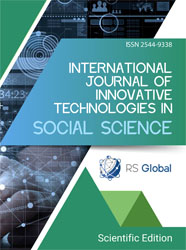THE IMPACT OF ORAL HEALTH ON HUMAN SECURITY
Abstract
To comply with the guidelines outlined in Article 3.4.1.1 of Mongolia's National Security Concept, which emphasizes "Human Security" and the promotion of public health, healthy lifestyles, and public health education, as well as Article 3.4.1.3, which focuses on proper nutrition, prevention of non-communicable diseases, and addressing micronutrient deficiencies, Mongolia has implemented two national programs aimed at oral health protection: the "Oral Health" program from 1999-2005 and 2006-2015, and the "Healthy Teeth - Healthy Children" program from 2019-2023. The World Health Organization (WHO) defines oral health as the overall well-being of the mouth, teeth, and gums, enabling individuals to perform essential functions like eating, breathing, and speaking. It also encompasses psychosocial aspects such as self-confidence and overall psychological well-being. Oral health is essential across all stages of life, from childhood to old age, and plays a crucial role in overall health, enabling individuals to fully engage in society and reach their potential. Oral diseases are largely preventable but pose a significant health burden in many countries, leading to illness, discomfort, and even mortality. These diseases share modifiable risk factors with other non-communicable diseases (NCDs), including sugar consumption, tobacco use, alcohol consumption, and poor hygiene, influenced by social and commercial factors. Common oral diseases include dental caries, periodontal disease, oral cancer, oral trauma, and cleft lip and palate, affecting approximately 3.5 billion people worldwide regardless of age or gender. Addressing oral hygiene at a systemic level is crucial, with developing countries facing higher prevalence due to factors like low household income, lack of oral hygiene knowledge, and inadequate national policies for prevention. Socio-economic disparities in oral health are pronounced among disadvantaged populations. The 2017 Mongolian National Oral Health Survey revealed high prevalence and severity of dental caries across different age groups, highlighting the need for comprehensive research in this area. Tooth decay can lead to infections in other organs, such as tonsillitis, cardiovascular disease, joint disease, kidney disease, diabetes, and allergies. It is considered both a lifestyle-related disease influenced by dental care and nutrition, as well as an infectious source that can be transmitted from an infected individual to a healthy person.
References
National security concept of Mongolia. Available at: https://legalinfo.mn/mn/detail?lawId=208070&showType=1
A75/10 Add.1. Draft global strategy on oral health. In: Seventy-fifth World Health Assembly, Geneva, 22–28 May 2022. Provisional agenda item 14.1. Geneva: World Health Organization; 2022. Available at: https://apps.who.int/gb/ebwha/pdf_files/WHA75/A75_10Add1-en.pdf (Accessed on 14 November 2022)
Global burden of disease 2019 (GBD 2019) results [online database]. Seattle: Institute of Health Metrics and Evaluation (IHME); 2020. Available at: https://vizhub.healthdata.org/gbd-results/ (Accessed on 14 November 2022).
Ministry of Health. Available at: https://moh.gov.mn/news/6940
Nutritional problems of the population of Mongolia. National Survey Report V. Available at: https://www.unicef.org/mongolia/media/1121/file/NNS_V_Sedevchilsen_tailan_MN.pdf
"Healthy teeth" action plan. . Available at: https://moh.gov.mn/uploads/files/6e510e9332047f5aaad88a0cd7c918ff050e25a5.pdf
HC Order No. 207 of 2013
Kearns CE, Watt RG. Transnational corporations and oral health: examples from the sugar industry. Community Dent Health. 2019; 36 (2):157–62. doi:10.1922/CDH_SpecialIssueKearns06.
El-Yousfi S, Jones K, White S, Marshman Z. A rapid review of barriers to oral healthcare for vulnerable people. Br Dent J. 2019; 227 (2):143–51. doi:0.1038/s41415-019-0529-7.
Marco A Perez, Lorna M D Macpherson. Oral diseases: a global public health challenge. Available at: https://pubmed.ncbi.nlm.nih.gov/31327369/#
Simmi Oberoi, Neha Chaudhary, Siriesha Patnalk, and Amarjit Singh, Understanding health seeking behavior, Family Medicine and Primary Care. 2016 Apr-Jun; 5(2).pp.463-464
Constitution of the World Health Organization. /Retrieved 2022.06.10/ https://www.who.int/about/govenance/constitution.
Global health security. Epidemic alert and response. FIFTY-FOURTH WORLD HEALTH ASSEMBLY. 21 May 2001. (Retrieved 2022.06.10) https://apps.who.int/gb/archive/pdf_files/WHA54/ea54r146pdf.
The 2021 Global Multidimensional Poverty index (MP). (Retrieved 2022.06.10) https://www.hdr.undp.org/en/2021-MPl.
Bradley Christian, Ajesh George Strategies to integrate oral health into primary care: a systematic review. BMJ Open. 2023 Jul 5;13(7):e070622. https://www.ncbi.nlm.nih.gov/pmc/articles/PMC10367016/#R1
Views:
124
Downloads:
42
Copyright (c) 2025 Bulgan Battsengel, Urjin Odkhuu, Delgertsetseg Jargaltsogt

This work is licensed under a Creative Commons Attribution 4.0 International License.
All articles are published in open-access and licensed under a Creative Commons Attribution 4.0 International License (CC BY 4.0). Hence, authors retain copyright to the content of the articles.
CC BY 4.0 License allows content to be copied, adapted, displayed, distributed, re-published or otherwise re-used for any purpose including for adaptation and commercial use provided the content is attributed.











